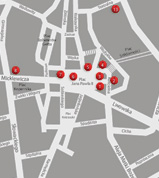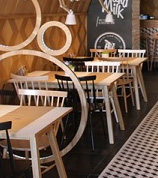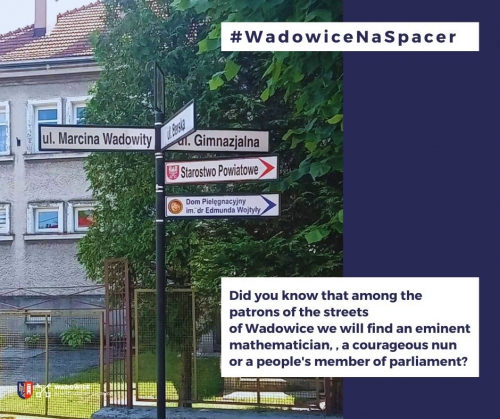
#WadowiceNaSpacer – A walk in the footsteps of the patrons of Wadowice streets
This Thursday, as part of our holiday series #WadowiceNaSpacer, we propose a walk in the footsteps of the patrons of Wadowice Streets. Did you know that among the people commemorated in this way, we will find an eminent mathematician, a courageous nun, or a people's member of parliament? We have many street patrons, but we presented figures who came from Wadowice or the surrounding area and significantly influenced the fate of the town.
A walk in the footsteps of the patrons of Wadowice streets is a great way to spend a summer afternoon. We prepared a Google map that will help you prepare for the route of the walk: https://www.google.com/maps/d/viewer?mid=1LU1P3CFW7GySeAx1Fk1jKDLKdqHM8Bg&fbclid=IwAR3oIsUOOEecAp9mGULueu3YV475CzHRBFjwR0LMWWvHTEqVsuTOTtlWo7I&ll=49.89246774779577%2C19.5553298&z=14
Wadowice:
- Ulica Jana Iwańskiego in Wadowice
Jan Iwański was born in 1849 in Okocim as the son of a carpenter Józef. After passing the matura exam, he studied at the Theological Faculty of Jagiellonian University, among other places. Eventually, he abandoned theology and entered the Jagiellonian University Faculty of Law. He received his doctoral degree in 1876. He began practicing law in Wadowice in 1883, where he took part in the famous emigration trial in late 1889 and early 1890. Iwański first became a town councilman in 1882 and as early as 1887 served as deputy mayor to Ignacy Brosig. After Brosig died in 1889, he became mayor, a position he held twice. During Iwański’s tenure, the first power plant in Wadowice was launched, and the construction of a water supply system was initiated. Among other things, he also showed initiative in the social and cultural fields as the vice-president of the TG „Sokół”( "Falcon" Polish Gymnastic Society) in Wadowice, a faculty member of the S.Batory Bursa Society, and founder of the Society for the Beautification of the Town of Wadowice and the Surrounding Area. His work for the benefit of Wadowice was recognized by the residents themselves; they awarded him the title of Honorary Citizen of Wadowice. Jan Iwański died in 1907 and was buried in the Wadowice parish cemetery. Crowds of residents attended his funeral. In 1909 the Town Council passed a resolution to name one of the town’s streets after the distinguished mayor.
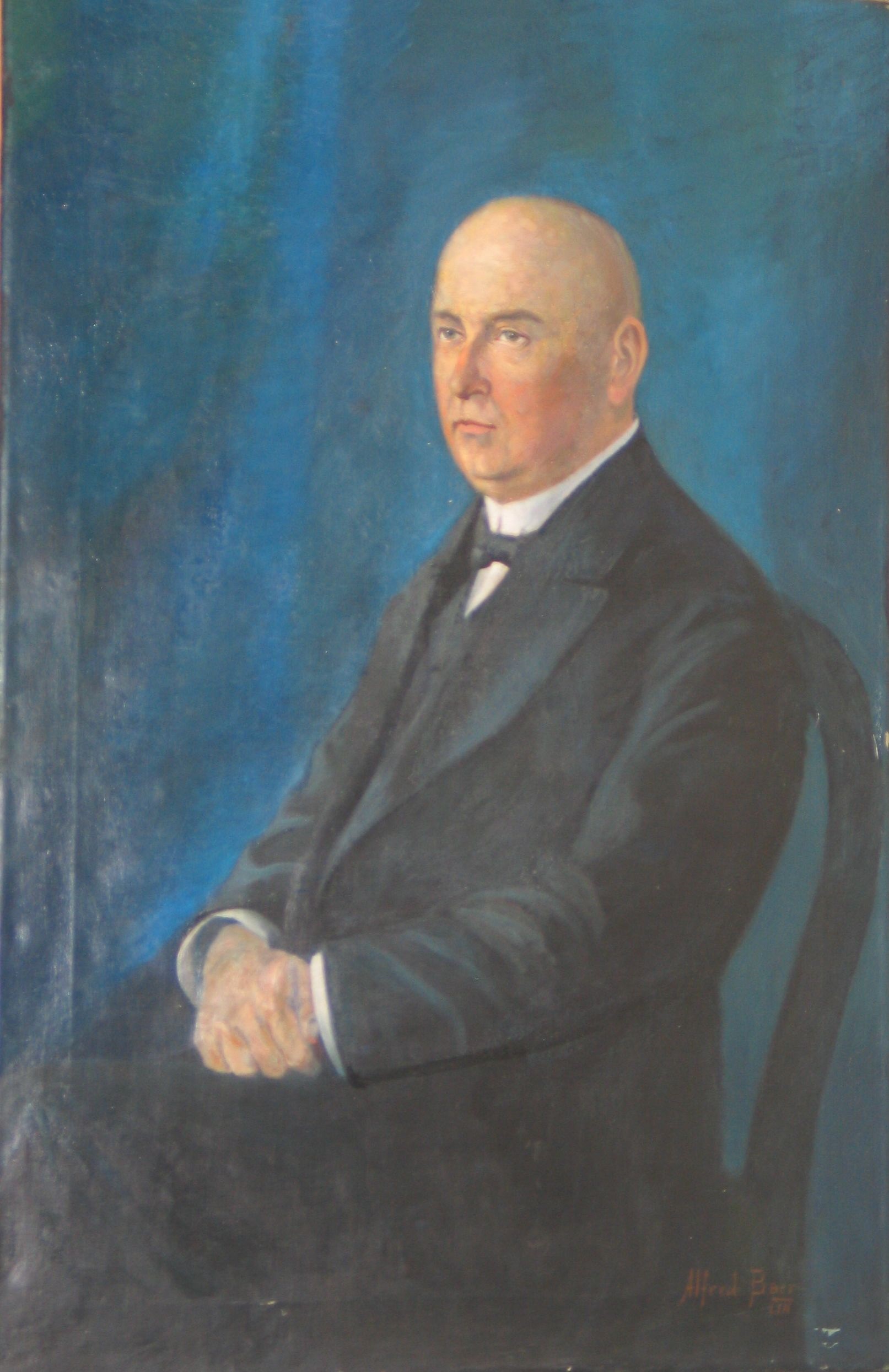
Photo : mayor J. Iwański, from the collection of the Town Musem in Wadowice
- Ulica Marcina Wadowity in Wadowice
Marcin Wadowita was a theologian, a profesor at the Kraków Academy (now Jagiellonian University). Wadowita, also known as Marcin Kępka, was born in Wadowice around 1567. His father served as a town councilor, his other relatives were also among the local elite. Beginning in 1583, he studied at the university of Kraków. He quickly attained further degrees, for by 1590 he was already a master’s degree holder. He was a lecturer at the Major and Minor Colleges. From 1600 he held the office of Dean of the Faculty of Philosophy at the Kraków Academy, and three years later became a bachelor of theology. Between 1605 and 1606 he studied in Italy, first in Rome and then in Padua. Wadowita was also supervising academic disputes.
In the years 1618 – 1636, he was dean of the Theological Faculty on several occasions, and in 1636 he became vice chancellor of the Kraków Academy and chancellor of the episcopal curia. He is credited with the authorship of 10 printed works, although he authored four theological treatises. He became a priest as late as 1602 and fulfilled his priestly ministry for the next 30 years. In 1598, he saved the Arian theologian Faust Socyn from oppression, who would die at the hands of enraged Kraków students. His hometown was proud of Wadowita’s successes, as the town’s ledger records information about his doctorate. He died in 1641 and was buried in St. Florian’s Church in Kraków. He donated part of his wealth to a scholarship fund for Wadowice youth. He also made emoluments to the Wadowice school and hospital.
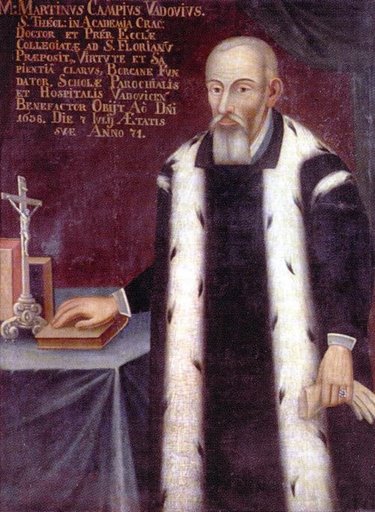
Photo : M. Wadowita, from the collection of the Town Musem in Wadowice
- Ulica Wincentego Bałysa in Wadowice
Wincenty Bałys was born in 1906 in Tomice near Wadowice as the son of Jan Kanty and Maria Witek. Soon after, the family moved to Wadowice’s Podstawie district. Since his childhood, Bałys had shown artistic ability by molding animals, buildings, or figureheads out of clay. He had his first experience in the sculpting technique in the stone workshop of Wadowice sculptor Józef Jura where he also met another future sculptor, Franciszek Suknarowski. In the years 1927 – 1932, Wincenty Bałys studied at the Academy of Fine Arts in Kraków, where he was admitted as an „extraordinary student”. During this period he honed his skills under the tutelage of masters Konstanty Laszczka and Xawery Dunikowski. Bałys not only sculpted in plaster, clay, and wood, but also made bronze casts, painted, and drew. Upon his return to Wadowice, he and Suknarowski established a sculpture studio, which was eventually located at Aleja Wolności 49. Wincenty Bałys was also associated with the artistic community centered around the manor house of Emil Zegadłowicz in Gorzeń Górny, where a group of visual artists called „Czartak” was formed under his leadership. Exceptional bonds of friendship also connected the artist with M. Kotlarczyk and K. Wojtyła. After the outbreak of the war, Wincenty Bałys organized an underground group – a cell of the „Orzeł Biały” organization. Unfortunately, it was uncovered and its members were arrested. After an investigation, the court sentenced Bałys and other Wadowice conspirators to death. The sentence was carried out at the so-called "Glinnik," near Kościuszko Mound in Kraków, on the 22nd of December 1939.
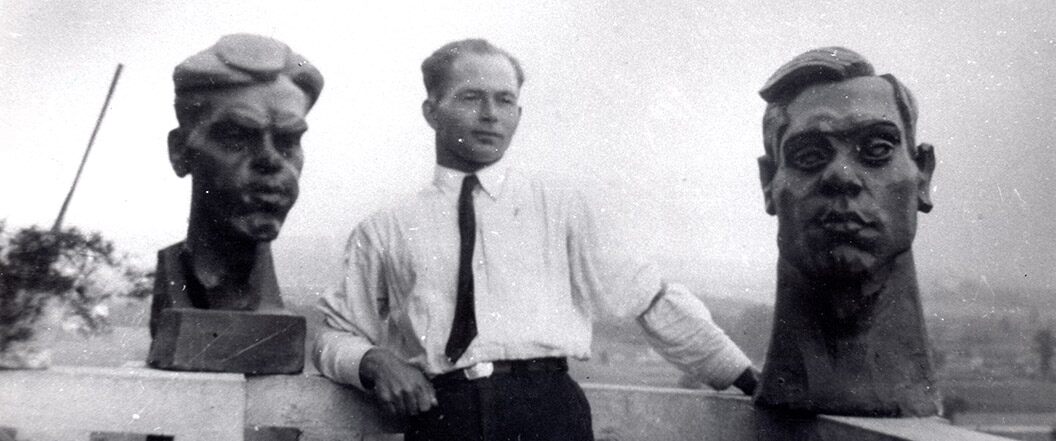
Photo : W. Bałys, from the collection of the Town Musem in Wadowice
- Ulica Doktora Józefa Putka in Wadowice
Józef Putek was a doctor of law, lawyer, mayor of Chocznia, and an activist in the people’s movement. He was born in 1892 in Wadowice. After graduating from high school in Kraków, he studied law at Jagiellonian University, graduating in 1920 with a doctorate. From 1908 he belonged to the Polskie Stronnictwo Ludowa (Polish People’s Party). During World War I he was an independence activist. Between 1919 and 1929 he served three times as mayor of Chocznia. In political and parliamentary activity, he was a supporter of land reform and an opponent of the privileged position of the church. In 1930 Józef Putek was arrested, imprisoned, and then released on bail from Brześć Fortress, returned to Chocznia, and prepared to take the bar exam. From 1931 he was a member of the Stronnictwo Ludowe (People’s Party). After the Brześć Trial, he was imprisoned in Wadowice, where he wrote historical works. Putek was an excellent speaker, known for his polemical eloquence and journalism. In the interwar period, he was a four-time member of the Legislative Sejm. During World War II he was arrested by the Germans in Chocznia in 1939 and imprisoned in Montelupich Prison in Kraków, then in Wiśnicz and transferred to Auschwitz concentration camp in 1940. From 1949 he was a member of the Polskie Stronnictwo Ludowe (Polish People's Party). He again became a member of parliament, this time in the National Council and the Legislative Sejm (1947 - 1952). In 1946 - 1948 he served as Minister of Post and Telegraph. In 1950 he was accused of involvement with the sanation, arrested and imprisoned. After serving his sentence he returned to Chocznia and from 1956 he worked as a lawyer and did not engage in political activity. Józef Putek died in 1974 in his hometown and was buried in the parish cemetery in Wadowice.
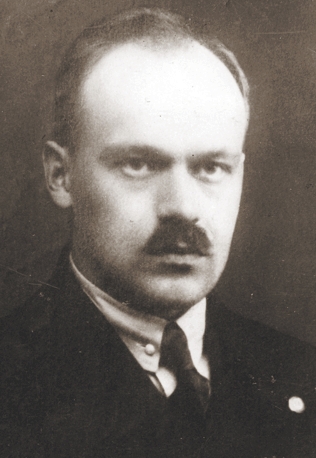
Photo : Wikipedia, public domain
- Ulica Generała Bruno Olbrychta in Wadowice
Bruno Olbrycht was a major general in the Polish Army, a participant in the Polish-Bolshevik War and both World Wars. He was born in 1895 in Sanok in the family of a veterinarian. After the family moved to Wadowice, he attended the local high school and was active in TG” Sokół” ("Falcon" Polish Gymnastic Society). He contributed to the development of Wadowice scouting. He was also a member of the secret Student Rifle Team. Since 1914, he commanded the 1st company of the so-called Wadowice Legionary Battalion. As a soldier of the Polish Legions, he fought in the Karpaty, Bukowina, and Wołyń campaigns. In the winter of 1918, he was interned in Hungary. Later he enlisted in the Polish Army and participated in battles on the front lines of the Polish-Ukrainian and Polish-Bolshevik wars. From 1927 to 1930 he was commander of the 2nd Legion Infantry Division in Kielce. He was a co-founder of the Kielce City Park and an active social activist in the city. Since 1930, as commander of the Infantry Training Center in Rembertów, he created a modern training and experimental facility on a European scale. From 1936 to 1938 he stayed in Zamość, where he was promoted to the rank of Brigadier General. He took an active part in the September campaign. Heavily ill and exhausted, he was taken into German captivity. Olbrycht became involved in the conspiracy under the pseudonym "Olza" and in 1944 became commander of the Home Army Operational Group "Śląsk Cieszyn", whose headquarters were located in a monastery in Kalwaria Zebrzydowska. In 1945. Olbrycht enlisted in the People's Army of Poland and became deputy commander of the Officer School of Infantry and Cavalry No. 1 in Kraków-Łobzów, head of the Department of Officer Schools of Infantry and Cavalry of the Ministry of Defense. He later became commander of the Warsaw Military District. Among other things, the general was tasked with fighting the post- Home Army underground independence movement in the Białystok, Warszawa, and Lublin provinces. He openly criticized (as one of the few) such a way of fighting. In 1946, at his request, he was transferred to the Infantry Training Center in Rembertów contributing to the expansion and modernization of this center. He supported those trainees who had served in the Home Army during the years of Nazi Germany's occupation. In 1947 he suffered another stroke and retired. He was treated in Kraków where he died in 1951. He was buried in the Rakowicki Cemetery, and in 1970 was exhumed and moved to Warsaw's Powązki cemetery.
%20-%20Dom%20%C5%BBo%C5%82nierza%20POlskiego.jpg)
Photo : Wikipedia, Polish Soldier's House
- Ulica Profesora Władysława Nikliborca in Wadowice
Władysław Nikliborc was a Polish professor of mathematics. He was born in 1889 in Wadowice to the family of a judge of the local District Court. He attended high schools in Bielsko, Rzeszów and Wadowice. He served in the Austro-Hungarian Army and the Polish Legions. In 1918-1922 he studied mathematics at the Jagiellonian University in Kraków, and in 1920 fought in the Polish-Bolshevik War. From 1922 to 1932 he was first an assistant, then an assistant professor in the Department of Mathematics at Lviv Polytechnic. He earned his doctorate in 1924 and his habilitation in 1927 at Jan Kazimierz University in Lviv. From 1928 to 1931, he was on a scholarship in Leipzig, Göttingen and Paris. In 1931, he received his habilitation in theoretical mechanics at Lviv Polytechnic. He then headed the Department of Theoretical Mechanics at Lviv Polytechnic from 1932 to 1937. In 1937, he moved to Warszawa. At that time he became an associate professor and head of the Department of Mathematics at the Faculty of Chemistry of the Warsaw University of Technology. He spent the war years 1939-1945 in Lviv, working all the time at the Lviv Polytechnic. In 1945, he was forced to leave Lviv and went to Warsaw, where he worked at the Warsaw Polytechnic. In 1947, he became a full professor. His wartime experiences left a great trauma on him. He died tragically in 1948 during his arrest by the Office of Public Security.
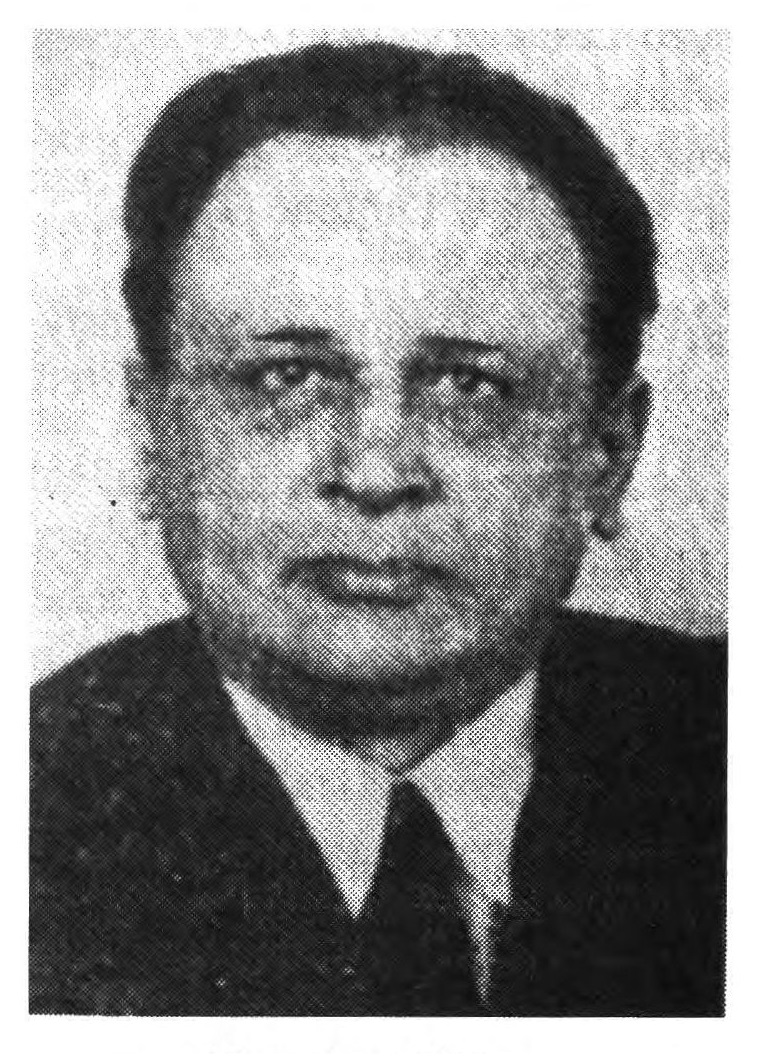
Photo : W. Nikliborc, from the collection of the Town Musem in Wadowice, Archives of the Polish Academy of Sciences
- Ulica S. Marii Małgorzaty Banaś in Klecza Dolna
Sister Maria Małgorzata Banaś was born in 1896 in Klecza Dolna near Wadowice as Ludwika Banaś to a family of farmers Jakub and Rozalia. At the age of 20, she began working at the hospital in Wadowice, where the Nazareth Sisters worked, and a year later (1917) decided to join their order and took the name Maria Małgorzata of the Dying Heart of Jesus in the Garden of Gethsemane. The sister performed simple ministries in religious houses in Wadowice, Stryj, Kraków, Grodno, and Warszawa. Then, in 1934, she was sent to a new post in Nowogródek, where the Nazareth nuns ran, among other things, a public school and took care of the parish. After the Soviets entered Nowogródek, the sisters had to take off their habits and leave the religious house. The years 1939-1943 mark the period of Sr. Maria’s work at the local hospital. She was the only one of the twelve Nazareth nuns who escaped execution by the Nazi Germans in 1943. After this event, she found the place of execution of her fellow sisters in the forest and was present at their exhumation. It was she who took care of the photographic documentation of these events. Thanks to, among others, her work, the Martyrs of Nowogródek were beatified by Pope John Paul II in 2000. After the war and the change of borders, despite the decision of other sisters to return to Poland, Sr. Maria remained alone in Nowogródek to continue her work. She died after a critical illness in 1966 in Nowogródek and was buried in the local cemetery. Sr. Maria’s beatification process started in 2008, and since 2021 she has been entitled Venerable Servant of God. Since 2022, a street in her hometown of Klecza Dolna has borne her name.
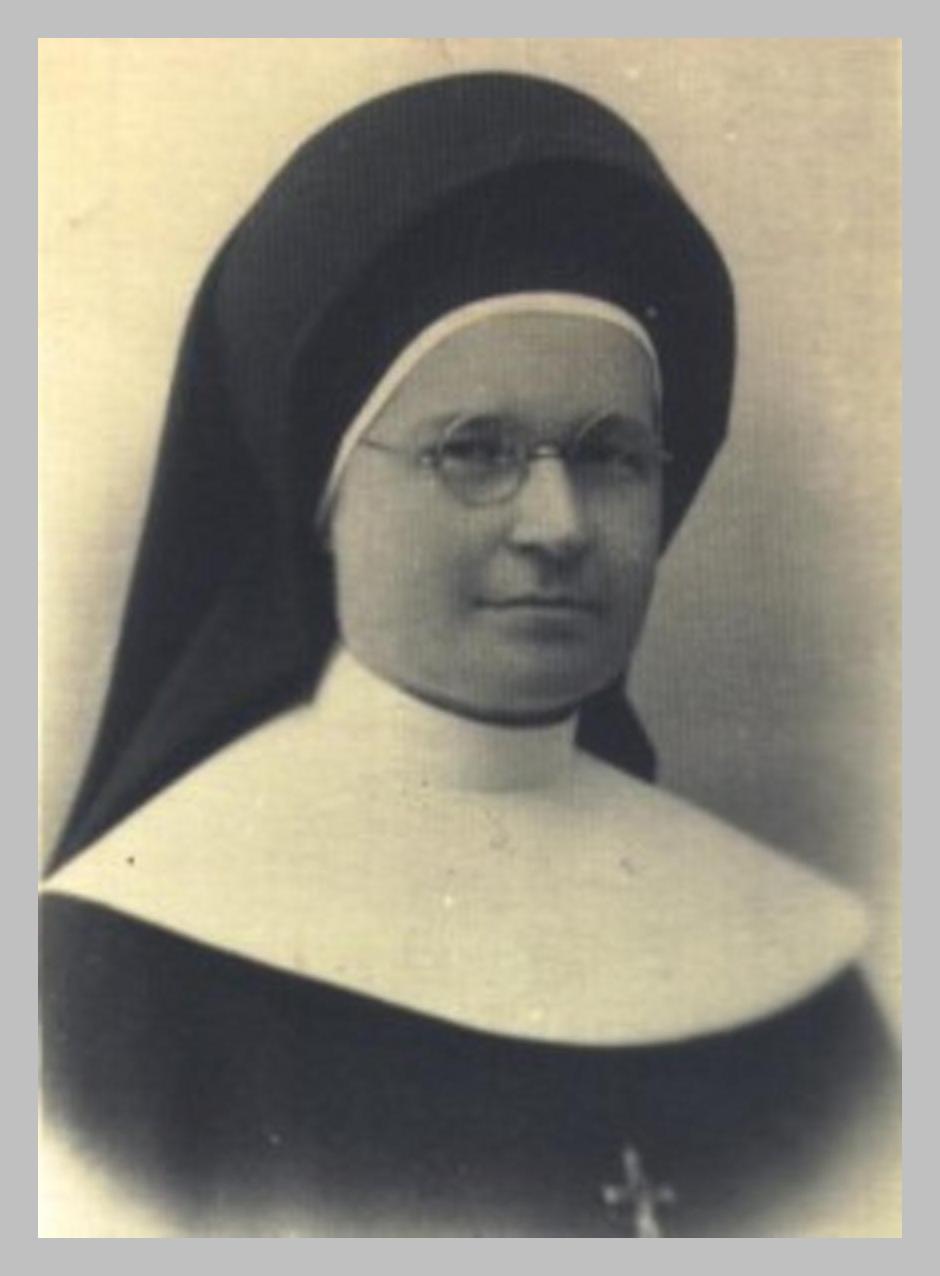
Photo : Nazareth Sisters Archive
- Ulica Ks. Zygmunta Kuźmy in Stanisław Górny
Fr. Zygmunt Kuźma was a parish priest in Stanisław Górny and co-founder of the Kolping Family in Poland. Fr. Kuźma served as the first parish priest of the newly erected parish of the Immaculate Heart of the Blessed Virgin Mary in Stanisław Górny since 1983. During his tenure, the construction of the temple, which began in 1980, was completed. At that time a fence surrounding the church was built and paved sidewalks were laid. A parsonage and parking lot were also built, and a cemetery was established. In time, a resident of Wadowice, retired Rev. Kazimierz Hoła, who bought a house in Stanisław, settled in the parish. In the sermons he delivered during masses, he introduced the faithful to the figure of Fr. Adolf Kolping and his work. Under their influence, Fr. Kuźma organized a group of about 40 people, who in 1990 founded the first Kolping Family in Poland - a Catholic association conducting activities for the benefit of local communities. In 1991, Fr. Kuźma, together with Stanisław parishioners, traveled to the Vatican to participate in the beatification of Fr. Adolf Kolping, who became the patron saint of all working people, especially those associated with the shoemaking craft and the modern leather and shoe industry. Priest Zygmunt Kuźma died in 2006.
Photo: Corner of Marcin Wadowita, Gimnazjalna and Barska streets in Wadowice, Wadowice Municipal Office Archives.
#Wadowice #WadowiceMunicipality #OnAWalk #KleczaDolna #StanisławGórny

.png)
